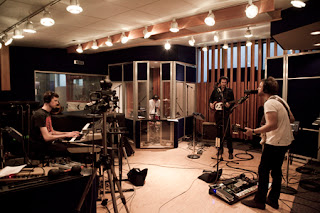Many musicians who have a lot of experience gigging never cut it in the studio. That's because they don't realize that the mentality of the studio is different. Where a gig is fairly loose and usually low pressure, the studio is more job-like and serious. Where on a gig every note you play is gone the second your play it, it may be kept forever in the studio and is under a microscope.
Playing in the studio is a different animal than on a gig and requires different mindset. Here are 5 tips from
How To Make Your Band Sound Great and
The Studio Musician's Handbook that will help you get off to a good start in the studio.
"You have to think differently when you’re about to do some serious recording. Let’s reinforce what it takes to think like a pro when it’s time for a recording session.
1. Arrive early. This goes without saying, but I’ll say it again to reinforce it. You should always arrive at least a half-hour before the downbeat of the session and if you’re a drummer or keyboard player with a lot of gear, then figure one full hour. Remember, if you’re late and you keep people waiting, it’s probably going to cost you money.
2. Turn your cell phone off! The session should be your main priority with as few distractions as possible and one of the easiest ways to achieve this is to turn off your cell phone. If you leave it on, not only do you risk ruining a good take if the ringer goes off, but talking on the phone is the best way to stop the momentum of a session in its tracks. And it’s so disrespectful to everyone else involved. Don’t even bother to put it on “vibrate” since this will cause you to lose your focus just as easily as when the ringer is on. Turn it off, then leave the phone outside the studio in the lounge so you won’t be tempted to use it.
3. Make sure your gear works. If you’re serious about recording, then everything has to work, from the smallest guitar cable to the largest amplifier. Not only does everything have to work, but it has to be in tip top condition as well. The better everything works and sounds, the better your recording will be.
Make sure that your gear is comfortable to you. Make sure everything's working, the cables aren’t crackling, your instrument is in tune and intonated, your tuner is working, and your amp sounds good. Make sure that you can set everything up quickly and be zero hassle to anybody, either technically or personally. Turn off your cellphone. Make it a point that everyone sees that you’re turning off your phone or leaving it outside the studio so they all understand that you’re not interested in phone calls while you’re working. Make the session a priority. -- Paul ILL: LA Session Bass Player (Pink, Christina Aguilera, Bill Ward, Tina Turner)
4. Be Prepared. Know just what you’re going to record. Have a plan, then have a backup in case things don’t work out the way you expect. Make any charts, notes, lyric sheets, or cheat sheets beforehand. You don’t want to be wasting anyone’s time for something that could so easily been done beforehand.
5. Bring everything to the session that you think you might need. Even if there’s only a remote possibility that a piece of gear might be needed, bring it anyway because you can bet it’ll be the one piece that will hold everything up if you don’t.
I over-kill. I bring so much more stuff than we’ll use because that’s part of the charm of hiring me. It’s part of the “oooh, aahh” factor, and also it’s to be of service to the muse and the spirit of the session. If you’re not sure what you’re going to be doing or where the music is going to go, that one extra piece that you bring can make the difference. I’ll bring as many basses as I can fit in my car for that day with a B-15. -- Paul ILL"
These prep tips are simple yet can be very important to the success of a session. Make them part of your studio routine.
To
read additional excerpts from How To Make Your Band Sound Great and The Studio Musician's Handbook, go to the excerpts section of
bobbyowsinski.com.
----------------------------------


